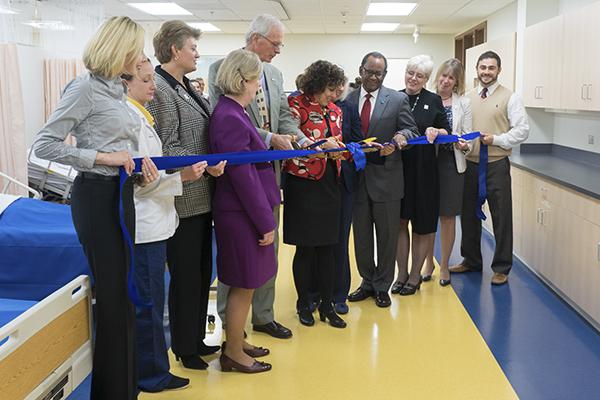A new state-of-the-art simulation lab is the latest addition to the School of Nursing’s push to be innovative and provide real life experience in the classroom.
The nursing school opened a skills and simulation lab Tuesday on the Virginia Science and Technology Campus to mimic the scenarios of patients in real hospital environments without the stresses and risks of real clinical trials. Students and faculty said the new lab will give students practical experience and reinforce critical skills before working with real patients.
The lab adds to already sprawling nursing facilities on the Virginia campus, and keeps up with the five-year-old school’s focus on practical experience for students. The simulation options allow students to gain hands-on experience before working with real patients.
Accelerated-track bachelor’s-in-nursing and veteran bachelor’s-in-nursing students will use 10 manikins, jointed models of the human body, in the new simulation lab. Each manikin will provide students with a chance to hone their skills with specific features on the manikin designed to mimic real situations like irregular heartbeats and breathing, even childbirth.
The lab includes an eight-bed ward area, two private patient rooms, a control room and a debriefing room.
The lab, part of the nursing school’s 10,000-square-foot hospital simulation laboratories, is called the Johnson Lab, to honor former Dean Jean Johnson. She said having her name on the lab is a “huge honor.”
Johnson served as the school’s inaugural dean, turning the department into a full-fledged school, and is still a faculty member.
Johnson said plans for the new lab started while she was still leading the school. She said she and other leaders in the school chose to direct their resources toward the new facilities because she believes the simulations are exciting resources for future nurses who have access to more recent technology.
“When I think about my education, I did my first injection and started my first IV and everything on a live patient. And now students have the opportunity to practice under the watchful eye of faculty, which is safer for patients,” she said.
She added that with current dean Pamela Jeffries being an “expert in simulation,” she expects to see more growth in the area in upcoming years.
“Much of her research is around that. Having her labs and having her expertise, she’s going to take it to the next level,” Johnson said.
Jeffries has studied simulation in nursing labs since 2001. This is the first simulation lab that has opened under Jeffries’ leadership at GW.
“Simulations are a beautiful vehicle and mechanism to practice teamwork for professional education and practice,” Jeffries said in an interview in August. “Not every school of nursing has the resources, so we’re very privileged here to have the resources and the space, and faculty are able to be trained to use these simulation labs with students.”
Karen Dawn, a professor and clinical instructor of nursing, said faculty work behind a two-way mirror in the lab. She said she and other faculty can activate the manikins with a remote control and can speak for the manikins.
“Many have personalities, and you have to know what kind of personality if you’re assigned them,” Dawn said. “We try and break the ice with our students and let them know that you have to do what makes the patient feel comfortable.”
The School of Medicine and Health Sciences has also increased hands-on training for students. Starting in 2012, students were required to take a more clinically focused curriculum, including classes in simulation labs.
Patty Davis, the director of clinical skills and simulation labs at the School of Nursing, said faculty lab personnel were involved in designing the lab and were able to chime in on how the space could best help develop students’ practical skills.
Kelley Finnegan, the president of the Student Nurses Association, said she hopes the lab will make her and other students feel more prepared for clinical examinations.
“I think that having the lab opportunity and the simulation experiences lets us run through those scenarios and think about how we would have to handle them as nurses,” Finnegan said. “If we never get an opportunity to run through them when we have instructors there and we’re dealing with manikin patients, I can only imagine how unprepared we would feel.”
Alexa Stuifbergen, the dean of the University of Texas’ nursing school, said simulation labs are a “great learning environment,” especially when students can reflect on and learn from their work during the simulations.
“Probably the most important part of simulation is the debriefing afterward,” she said. “It’s the opportunity that students and teams of students have to look at and say, ‘Wow, I didn’t realize.’”
Ellie Smith contributed reporting.






